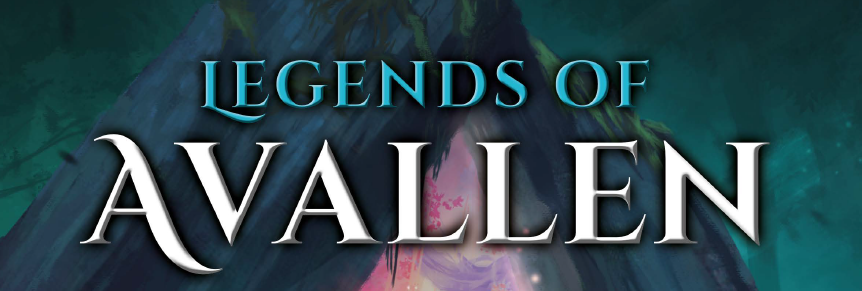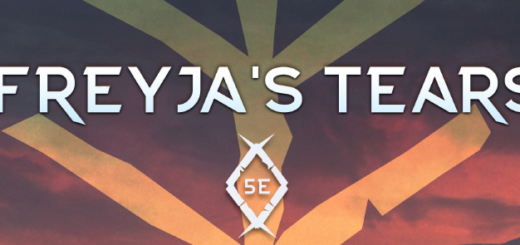Review of Legends of Avallen – a celtic inspired Roleplaying Game

It’s been a while since my last review of Beyond the Wall – Further Afield, and today we’re going to take a look at Legends of Avallen. It was in the final stages of the Kickstarter when Deren brought this work to my attention. He and his wife created Legends of Avallen together and even found a publisher in Modiphius during the Kickstarter. Inspired by Celtic mythology from the Roman-British period, the whole game takes the characters across an island that is home to tribes of nature-bound people, provides a link to the Otherworld, and has recently been claimed in part by faithless invaders.
TL;DR
In Legends of Avallen, our story begins as a common member of a village from a tribe. Each tribe is subordinate to a clan in Avallen. We choose a profession, get better at it and go on quests. At certain levels, our character evolves and takes on classes like the warrior or mystic, paving the way into one of the four legendary paths of each class.
The rulebook is bursting with in-game text, phonetics for names that are very difficult for some to pronounce such as Ffieidd-Dra (fee-AYTH-dra), and beautiful artwork to highlight a wondrous world. There is the conflict between technology with the Raxian Empire as well as the nature-bound Vallic tribes, all of whom have a special reverence for one of the five gods and tap into the arcane and mystic.
The rules are unusual, but not overly complicated. Particularly nice to read is the character development, the rules for social conflicts as a separate mini-game and that there are ways to increase the card luck a bit more tactically.
An exciting game for friends of mythical worlds and legendary stories!
- Publisher: Modiphius
- Release Year: 2021
- Language: English
- Pages: 244
- Format: PDF / Print
- Price: 24,95 € / 42,95 € at Modiphius
Avallen
During the Age of Gods, there were five heroes who stood against the Wild Hunt and brought the battle to the Otherworld. Touched by this strange and unknown world, where even time passes differently, they returned to the Vallic tribes. Inspired by their deeds, the tribes joined together in an oath of loyalty under these individual heroes and formed the now great clans of Pen Cawr, Pen Baedd, Pen Levi, Pen Draig and Pen Afanc. To maintain stability, the heroes now known as Gods went back to the Otherworld and oversaw the powers and influences of the worlds. Thus began the age of legends.
The Otherworld is home to Fae and other creatures of British and Celtic mythology. Thus, the "children" of the gods are found here in various forms. At the same time, the Ffieidd-dra (fee-AYTH-dra) are abominations that were banished to the Otherworld during the Wild Hunt. Occasionally, some of these creatures flee to Avallen, but none of the ancient beings yet pose an ultimate threat to the island.
The Raxian Empire set course for Avallen, and with the help of Pen Cawr, they were able to find their place on the island. With the glorious metropolis of Ataraxia, the Raxians expand their influence and show the prosperity with social centers, bathhouses and artificial rivers that technology brings them. After the death of the Emperor, his daughters are now named Twin-Empresses, which not everyone in the Senate secretly approves of. For a long time there was war between the native Vallic and the Empire, but a truce was called and negotiated. Nevertheless, tensions persist, and a resistance is gathering in the north, even from the ranks of the Pen Cawr.
Core Rules
Cards instead of Dice
Instead of dice, Legends of Avallen uses a normal poker deck. There are four attributes, each of which is assigned to a card suit:
- Vigour – Hearts
- Agility – Diamonds
- Spirit – Spades
- Wit – Clubs
For each check, the game master sets a level of difficulty. Basically, each character has a modifier in its attributes, starting with a distribution of +1, 0, 0, -1 at character creation. This value is already added to the check.
When a card is drawn, there are different situations. If the color (red/black) associated with the attribute is drawn, you get +1 on the check. In case you draw the exact suit of the card (hearts, diamonds, spades, clubs), you get +2. If you draw a court card (jack, queen, king, ace), the value is doubled. The opposite is true if you draw the wrong color (red/black) or even the opposite suit. Each suit has an opposite position (hearts – clubs, diamonds – spades). So if you draw the 7 of clubs in a Vigour test, the card gives -2 to the check. With a Jack of Clubs, it would even be -4.
Avoiding Fate
To avoid drawing the wrong cards, there are advantage and disadvantage from now many other game systems. However, we can have more than one advantage or disadvantage here, which cancel each other out. So three advantages and one disadvantage lead to two advantages that we may apply. For each advantage or disadvantage we have left over after this short calculation, we draw additional cards. If the advantages outweigh the disadvantages, we choose the best card for us from the drawn cards. If there is a disadvantage, we have to choose the worst card.
Additionally, we get a so-called Edge if we fail or critically succeed in a check. This is a card that we draw face down and place in front of us. When we have to do a check, we may add this card to it and choose. It is treated like an advantage. Otherwise, the Edge may be necessary for some of the character’s other abilities.
Another special feature to prevent failure is the so called exerting. You can turn a failure into a success. Exerting can be applied to your own character or to items used in the check. You can also use exerting multiple times to turn critical failures into successes. By the way, it also works against checks that someone directs at your own character. In parleys – social conflicts – this rule may not be used, as it is equivalent to losing face. You can only use Exerting once and must rest afterwards to remove the condition from your character. For items, a small box will note that the item is broken and must be repaired accordingly.
Character Growth
It is assumed that our character is a Vallic, a native person of Avallen. While you can also play under the banner of the Raxian Empire, most character development paths stick closer to the Vallic. At the beginning of the game, you choose a profession. These include alchemist, bard, crafter, merchant, priest, scholar, socialite, thief, tamer, and scavenger. Each profession has three skills that we can use through a profession kit. For the third skill, the kit must be upgraded. These are all not powerful skills, but helpful professions in combination with later classes or group constellations. For example, crafters can repair or craft items, scavengers can replenish supplies through well scavenging and use monster organs to make cloaks with their skills.
Advancing in Level happens every two quests. The play style is quest-based in this game, which is how you become known. After every second quest, you go up a level. In between, you get an attribute increase. There are 15 levels in total, which are divided into: Apprentice, Adventurer, Veteran, Hero and Legend.
Classes
At level 2, you directly choose a class. There are four of them in the game:
- Warrior
- Reaver
- Mystic
- Mage
Each class has different styles. A warrior thus has the great weapon combat, wrestling, shield combat and protection style. From level 5 you choose one of the four legendary paths of each class. In this, each class has one unique path and three that are shared with other classes. In the case of shared legendary paths, you also gain the class with which you share the path. So if you choose Primus as a warrior, you also gain the class of mage. As with The Shadow of the Demon Lord, you first gain new profession, class, and legendary path abilities at different levels and have not already extensively learned profession and class at level 5.
Traits and Reflection
As a special feature, there are also character arcs. During the character creation you choose a motivation, virtue and a personal flaw of your own character. Besides the inner conflict, these character traits are supposed to make you commit to certain situations and oaths. When these are resolved, one also receives a bonus to checks. But while one’s own character becomes more and more a legend, this behavior and the perception of one’s own personality also changes. So the character is confronted with their own virtues and gripes not only on a narrative level but also on a rules level as they level up.
Conclusion
Presentation
The book itself is well structured, has a clean and clear layout, wonderful artwork and comes directly with a first quest. The fluff texts are very thematic and make the world seem alive. Repetition of boilerplate text means that you don’t have to wildly look up finer points of the rules. The sections are short and concise. However, that’s exactly how you need to understand the lore. For people who expect deep lore, there is of course still room in the rulebook on the approx. 244 pages, otherwise it would be a much longer book. But it gives a good impression of the world and lore and offers a lot of inspiration for your own interpretation of Avallen, the Otherworld and the Empire.
Rules
When I started reading the work, I was skeptical. I didn’t know what to expect and the core rules sounded unfamiliar and also tough. However, the more I dug into the work, the more I realized that there are many possible combinations and that the competence of the characters also increases properly. I also liked the development on a personal level and the way the topic of legends is dealt with. Writing down the individual quests already leads to a kind of fame and exactly that is reflected by a social status, which also allows to talk to people of status and name.
At the same time, this is exactly how the NPC and monster statblocks are abstracted. They are classified into individual ranks and then have basically the same stats and otherwise they have their own motivations, abilities and tierings. In the same way, coins are also counted only at the highest level and go along with social rank. If you are noble, you are no longer interested in copper coins and you don’t have to keep a book about it.
I especially liked the social conflict, which not only requires a carefully plotted dialogue, but also tests the motivations and personal attitudes of the other person and the patience of the other party, and thus forms an end to the parley. All in all, Legends of Avallen reads like a well-tuned game in a carefully written world with a hell of a lot of words that read unpronounceable, describing stories from the common man to the legend without setting too high a power level, but feeling comfortable in the mythology. This advantage is in my opinion also the drawback: It is a very strong theme and therefore not your normal fantasy game, which you have to like!











